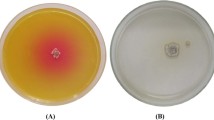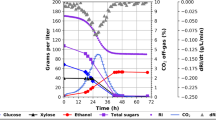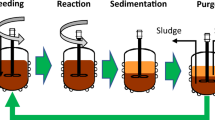Abstract
The development of a continuous fermentation system with immobilized microorganisms for manufacturing biochemicals is described. Data for Saccharomyces cerevisiae producing ethanol is used as an example of reactor kinetics. A mini-bioreactor was used to obtain the kinetic data, which is useful in designing pilot plant and production scale reactors. Electron micrographs illustrate how the yeast cells populate the IMC beads and escape into the fermentation liquor. A method using cascaded fluidized beds with individual recirculation loops for oxygenation and fluidization is described.
This is a preview of subscription content, access via your institution
Access options
Subscribe to this journal
Receive 12 print issues and online access
$209.00 per year
only $17.42 per issue
Buy this article
- Purchase on Springer Link
- Instant access to full article PDF
Prices may be subject to local taxes which are calculated during checkout
Similar content being viewed by others
References
Messing, R.A. 1980. Immobilized microbes, p. 105–121. In: Annual Reports on Fermentation Processes. Vol. 4. D. Perlman (ed.), Academic Press, New York.
Abbott, B.J. 1977. Immobilized cells, p. 205–233. In: Annual Reports on Fermentation Processes, Vol. 1. D. Perlman (ed.), Academic Press, New York.
Abbott, B.J. 1978. Immobilized cells, p. 91–123. In: Annual Reports on Fermentation Processes, Vol. 2. D. Perlman (ed.), Academic Press, New York.
Durand, G. and Navarro, J.M. 1978. Immobilized microbial cells. Process Biochemistry 13: 14–23.
Novick, A. and Szilard, L. 1950. Experiments with the chemostat on spontaneous mutations of bacteria. Proc. Nat. Acad. of Sci. 36: 708–719.
Chibata, I. 1979. Immobilized microbial cells with polyacrylamide gel and carrageenan and their industrial applications, p. 187–202. In: Immobilized Microbial Cells. K. Venkatasubramanian (ed.), ACS Symp. Series 106, Washington, DC.
Venkatasubramanian, K., Karkare, S. and Vieth, W.R. 1983. Chemical engineering analysis of immobilized cell systems. Applied Biochemistry and Bioengineering 4: 311–349.
Venkatasubramanian, K. and Karkare, S., 1983. Process Engineering Considerations in the Development of Immobilized Living Cell Systems, p. 133–144. In: Immobilized Cells and Organdies, Vol. 2. B. Mattiason (ed.), CRC Press, Boca Raton, Florida.
Nilsson, K., Scheirer, W., Merten, O.W., Ostberg, L., Liehl, E., Katinger, H.W.D. and Mosbach, K. 1983. Entrapment of animal cells for the production of monoclonal antibodies and other biomolecules. Nature 302: 629–630.
Nilsson, K. and Mosbach, K. 1980. Preparation of immobilized animal cells. FEBS Letters 118: 145–150.
Kuu, W.Y. and Polack, J.A. 1982. Kinetic parameter estimation for reaction systems of immobilized cells and enzymes. Presented at 75th Annual AIChE Meeting in Los Angeles, CA, November 14–18.
Cysewski, G.R. and Wilke, C.R. 1978. Process design and economic studies of alternative fermentation methods for the production of ethanol. Biotech and Bioeng. 20: 1421–1444.
Author information
Authors and Affiliations
Rights and permissions
About this article
Cite this article
Karkare, S., Dean, R. & Venkatasubramanian, K. Continuous Fermentation with Fluidized Slurries of Immobilized Microorganisms. Nat Biotechnol 3, 247–251 (1985). https://doi.org/10.1038/nbt0385-247
Received:
Accepted:
Issue Date:
DOI: https://doi.org/10.1038/nbt0385-247



